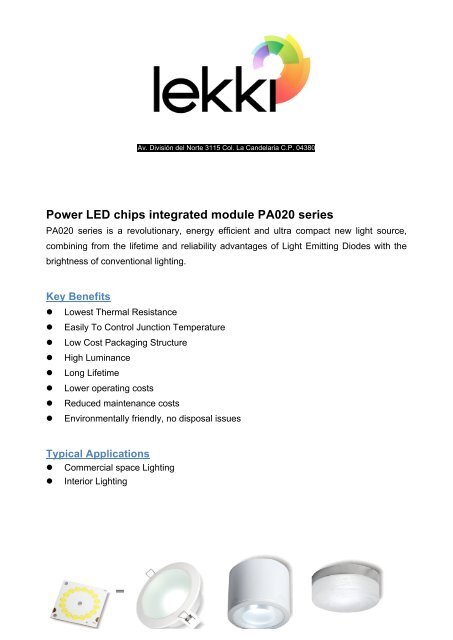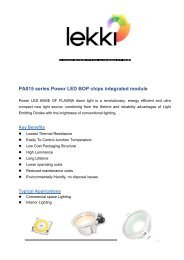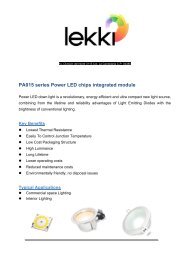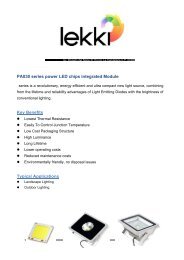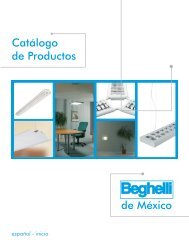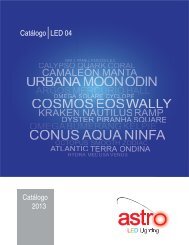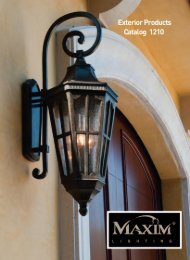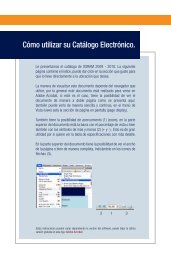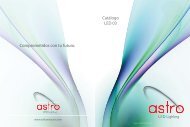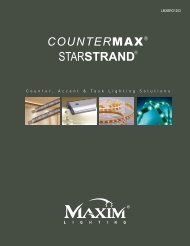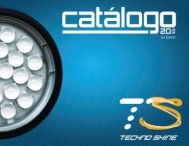Power LED chips integrated module PA020 series
You also want an ePaper? Increase the reach of your titles
YUMPU automatically turns print PDFs into web optimized ePapers that Google loves.
Av. División del Norte 3115 Col. La Candelaria C.P. 04380<br />
<strong>Power</strong> <strong>LED</strong> <strong>chips</strong> <strong>integrated</strong> <strong>module</strong> <strong>PA020</strong> <strong>series</strong><br />
<strong>PA020</strong> <strong>series</strong> is a revolutionary, energy efficient and ultra compact new light source,<br />
combining from the lifetime and reliability advantages of Light Emitting Diodes with the<br />
brightness of conventional lighting.<br />
Key Benefits<br />
l Lowest Thermal Resistance<br />
l Easily To Control Junction Temperature<br />
l Low Cost Packaging Structure<br />
l High Luminance<br />
l Long Lifetime<br />
l Lower operating costs<br />
l Reduced maintenance costs<br />
l Environmentally friendly, no disposal issues<br />
Typical Applications<br />
l Commercial space Lighting<br />
l Interior Lighting
Precaution<br />
l Don’t touch, push or squish the light emitting area<br />
Do not touch the <strong>LED</strong> Array or resin area during operation. Allow the <strong>LED</strong> Array to cool for<br />
a sufficient period of time before handling. The <strong>LED</strong> Array may reach elevated<br />
temperatures such that it can burn skin when touched.<br />
Emitting area<br />
Revision :3.1 Page 1 of 14<br />
I
Table of Contents<br />
Technology Overview ..................................................................... 3<br />
Average Lumen Maintenance Characteristics ................................ 3<br />
Environmental Compliance ............................................................ 3<br />
Product Nomenclature .................................................................... 4<br />
Dimensions ..................................................................................... 5<br />
Circuit Layout ................................................................................. 6<br />
Absolute Maximum Ratings ............................................................ 7<br />
Forward Voltage Characteristics .................................................... 8<br />
Operating Current and Luminous Flux Characteristics .................. 8<br />
Reliability Test ................................................................................ 9<br />
Color Temperature Characteristics .............................................. 10<br />
Color Spectrum ............................................................................ 10<br />
Recommend Heat Sink Surface Area .......................................... 12<br />
How to measure the junction temperature ................................... 13<br />
Assembly ...................................................................................... 14<br />
Revision :3.1 Page 2 of 14<br />
I
Technology Overview<br />
EDISON ® Light Emitting Diodes Product benefit from a suite of innovations in the fields of<br />
chip technology, packaging, and thermal management. These breakthroughs allow<br />
illumination designers to achieve efficient light engine designs and deliver high brightness<br />
solutions. Furthermore, the COHS ® design can be to reduce thermal resistances between<br />
<strong>chips</strong> and heat sink, easily to control junction temperature.<br />
<br />
Average Lumen Maintenance Characteristics<br />
Lifetime for solid state lighting devices (<strong>LED</strong>s) is typically defined in terms of lumen<br />
maintenance—the percentage of initial light output remaining after a specified period of<br />
time.<br />
EDISON ® to expect that Pacific-S <strong>series</strong> products will deliver, on average 90% lumen<br />
maintenance at 50,000 hours of operation at suggested forward current. This projection is<br />
based on constant current operation with junction temperature maintained at or below<br />
70°C.<br />
Environmental Compliance<br />
EDISON ® Light Emitting Diodes help reduce power consumption and the amount of<br />
hazardous waste entering the environment. All EDISON ® products manufactured by<br />
EDISON ® are RoHS compliant and free of hazardous materials, including lead and<br />
mercury.<br />
Revision :3.1 Page 3 of 14<br />
I
Product Nomenclature<br />
The following table describes the available color, power type etc.<br />
<br />
PA 015 C CU H - 001<br />
Pacific <strong>Power</strong> Packaging<br />
Color Substrate<br />
Type<br />
Order Code Format<br />
Initial <strong>Power</strong> Color Substrate Packaging Type<br />
PA XXX Cool White CU (Copper Heat Sink) Horizontal PN Chip xxx<br />
Notes for Table 1:<br />
“x” Stands for 1 digit<br />
Example:<br />
PA015CCUH-001<br />
Neutral White AL(Aluminum Heat Sink) Vertical PN Chip<br />
Warm White FR (Fiber Reinforced Plastic) Flip-Chip<br />
AC <strong>Power</strong><br />
Pacific Series / 15 watts / Cool White Color / Copper Heat Sink Substrate / Horizontal PN<br />
Chip Package / Type 001.<br />
Revision :3.1 Page 4 of 14<br />
I
Dimensions<br />
Color code are replaced with question mark “?” in product code.<br />
<strong>PA020</strong>?CUH-001&002<br />
<br />
Notes:<br />
Top View<br />
Front View<br />
1. Solder pads are labeled “+” and “-“ to denote positive and negative, respectively.<br />
2. Drawings are not to scale.<br />
3. Drawing dimensions are in millimeters.<br />
4. Unless otherwise specified, tolerances are ± 0.20mm.<br />
Bottom View<br />
5. The optical center of the <strong>LED</strong> Array is defined by the mechanical center of the array.<br />
Revision :3.1 Page 5 of 14<br />
I
Circuit Layout<br />
Product code below neglect color、substrate and package code, for example instead of<br />
PA015CCUH-001 with PA015-001.<br />
<strong>PA020</strong>-001<br />
<strong>PA020</strong>-002<br />
Revision :3.1 Page 6 of 14<br />
I
Absolute Maximum Ratings<br />
The following table describes absolute maximum ratings of Pacific-S <strong>series</strong>. Please refer<br />
to circuit layout on previous page for DC forward current & voltage selection.<br />
Product code below neglect “PA”、color、substrate and package code, for example instead<br />
of PA015 CCUH-001 with 015-001.<br />
Table 2.<br />
Parameter Range Unit Symbol<br />
<strong>LED</strong> Junction Temperature
Forward Voltage Characteristics<br />
The following tables describe forward voltage of Pacific-S005 <strong>series</strong>. Please note that the<br />
all forward voltage range is based on constant driving current. Do not base on the values<br />
below to design a constant voltage system.<br />
Product code below neglect color、substrate and package code, for example instead of<br />
PA015CCUH-001 with PA015-001.<br />
<strong>Power</strong> Min. Voltage<br />
(VF)<br />
Table 3.<br />
Typ.Voltage<br />
(VF)<br />
Max.Voltage<br />
(VF)<br />
<strong>PA020</strong>-001 11.9 13.2 14.5 V<br />
<strong>PA020</strong>-002 23.8 26.4 29.0<br />
Notes for Table 3:<br />
Forward voltage is measured with an accuracy of ±10%<br />
Operating Current and Luminous Flux Characteristics<br />
The following tables describe luminous flux at Ta=25°C for Pacific-S <strong>series</strong> at DC forward current<br />
suggested above.<br />
Unit<br />
Product code below neglect “PA”、color、substrate and package code, for example instead of<br />
PA015CCUH-001 with 015-001.<br />
Table 4.<br />
Color 020-001 020-002 Unit<br />
Cool White 4058 4058 lm<br />
Neutral White 3785 3785<br />
Warm White 3238 3238<br />
Notes for Table 4:<br />
1. Luminous flux is measured with an accuracy of ±10% with 170°<br />
Revision :3.1 Page 8 of 14<br />
I
Reliability Test<br />
The following table describes operating life, mechanical, and environmental tests<br />
performed on EDISON ® Pacific-S <strong>series</strong>.<br />
Table 5.<br />
Stress Test Test Description<br />
Revision :3.1 Page 9 of 14<br />
I<br />
Stress<br />
Duration<br />
Natural Drop Equivalent drop height 112cm *<br />
High temperature<br />
operation or storage<br />
125°C 1000 hours<br />
High temperature &<br />
Humidity<br />
85°C/85%RH 1000 hours<br />
Temperature Cycle<br />
–40/115°C,15min dwell/<br />
Color Temperature Characteristics<br />
The following tables describe color temperature of Pacific-S <strong>series</strong>.<br />
Product code below use “x” instead of power、substrate and package code, for example<br />
instead of PA015CCUH-001 with PAxxxCxxx-xxx.<br />
Table 6.<br />
Order Code Color λd / CCT<br />
Min. Max<br />
PAxxxCxxx-xxx Cool White 5000 10000 K<br />
PAxxxNxxx-xxx Neutral White 3700 5000 K<br />
PAxxxWxxx-xxx Warm White 2600 3700 K<br />
Notes for Table 6:<br />
1. CCT is measured with an accuracy of ± 200K.<br />
Color Spectrum<br />
Cool White Color Spectrum<br />
Unit<br />
Cool White Spectrum<br />
350 400 450 500 550 600 650 700 750 800 850 900 950 1000 1050<br />
Wavelength(nm)<br />
<br />
Revision :3.1 Page 10 of 14<br />
I
Neutral White Color Spectrum<br />
<br />
Warm White Color Spectrum<br />
Neutral White Spectrum<br />
350 400 450 500 550 600 650 700 750 800 850 900 950 1000 1050<br />
Wavelength(nm)<br />
Warm White Spectrum<br />
350 400 450 500 550 600 650 700 750 800 850 900 950 1000 1050<br />
Wavelength(nm)<br />
<br />
Revision :3.1 Page 11 of 14<br />
I
Recommend Heat Sink Surface Area<br />
The following tables describe recommend heat sink surface area to make sure the<br />
junction temperature Tj below 70°C and ensure the product’s life time of Pacific-S <strong>series</strong>.<br />
Chip Distribution<br />
Square<br />
Circle<br />
*Note 1<br />
Note 1 : Describe about die distribution.<br />
Square : example as below<br />
Circle : example as below<br />
Table 7.<br />
Wattage<br />
Suggested Surface<br />
(W)<br />
Area<br />
(cm 2 )<br />
5 150<br />
7 300<br />
10 500<br />
15 800<br />
20 1000<br />
30 2500<br />
40 3200<br />
50 4000<br />
60 >4000<br />
100 >15000<br />
120 >20000<br />
10 500<br />
15 500<br />
20 500<br />
Test point<br />
Revision :3.1 Page 12 of 14<br />
I
How to measure the junction temperature<br />
It’s very easily to make sure the junction temperature by measure the temperature of test<br />
point designed on the substrate near the <strong>chips</strong>. By choose suitable heat sink and measure<br />
the test point temperature to make sure the junction temperature at least below 80°C .<br />
1. Attach product on the heat-sink<br />
with high heat conductive paste.<br />
Test point.<br />
Via diameter 1.0mm<br />
2. Let the thermal wire contact the<br />
via bottom metal and fixed.<br />
Suggest thermal wire diameter<br />
below 0.15mm<br />
Thermal meter<br />
3. Light on and waiting for heat equilibrium.<br />
The equilibrium time depend on the<br />
heat-sink size you chose. Normally 2.5hr<br />
waiting time is necessary.<br />
4. Read temperature and plus 3 degree will<br />
be the junction temperature.<br />
Revision :3.1 Page 13 of 14<br />
I
Assembly<br />
We suggested using Pacific-S will be easier to apply to in lighting application. It’s can use<br />
screws to fix at lampshade or metal utilities. We strongly recommended using as graphite<br />
between lampshade or utilities metal.<br />
Graphite<br />
Heat Sink<br />
Drawing Not to Scale<br />
<br />
For the Circle emitter products (020-001&002), preferred screw mounting locations are<br />
indicated in Figure7.<br />
Screw<br />
Emitter<br />
<br />
Graphite 0.5t/mm (Reference)<br />
Pacific-S <strong>series</strong> (Reference)<br />
Heat Sink (Reference)<br />
Revision :3.1 Page 14 of 14<br />
I


